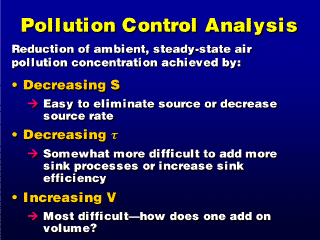 To reduce pollution concentration inside a box, you need to reduce the source
rate, reduce the residence time, or increase the box volume.
To reduce pollution concentration inside a box, you need to reduce the source
rate, reduce the residence time, or increase the box volume. To reduce pollution concentration inside a box, you need to reduce the source
rate, reduce the residence time, or increase the box volume.
To reduce pollution concentration inside a box, you need to reduce the source
rate, reduce the residence time, or increase the box volume.
Reduction of the residence time is accomplished with anthropogenic sink techniques. This may be the use of filtration devices (deposition), or ventilation (dispersion) by opening a window or door.
Increasing the box volume is done by moving the walls of the box farther apart. This is not very practical in most cases. If you are the source of the pollution, then moving yourself into a larger room is the same as increasing the volume, though the actual location has changed. One could make the case that opening a window or door increases the effective volume by adding the volume of another room or the outdoors to the volume of the current room.
Reduction of the source rate would be the most direct route to reducing the steady-state box concentration and is usually the easiest method, not considering the social/economic/political ramifications of such a reduction.
An interesting dynamic situation occurs when we reduce the source rate and
keep the residence time and box volume constant, because if you do this reduction
suddenly, the sink rate does not immediately reduce itself to be equal to the
source rate; thus, the box concentration will not be in steady-state.
The pollution concentration decreases initially, because the sink rate at this
moment is greater than the source rate. As the concentration decreases, however,
the sink rate decreases (sink processes become less efficient as the ambient
concentration of pollutant decreases). At some point, the sink rate will have
decreased so it equals the source rate, at which time the box concentration
will become steady-state (source=sink).